
An RQ-4 Global Hawk sits on the tarmac at Yokota Air Base, Japan, Wednesday, May 24, 2017. (Leon Cook/Stars and Stripes)
YOKOTA AIR BASE, Japan — The Air Force showed off one of its newest and most high-tech intelligence-gathering platforms this week in western Tokyo.
Reporters were welcome to film, photograph and even touch an unmanned RQ-4 Global Hawk surveillance plane Wednesday at Yokota Air Base, home of 5th Air Force and U.S. Forces Japan.
The gray aircraft — which belongs to Detachment 1 of the 69th Reconnaissance Group, 9th Reconnaissance Wing out of Andersen Air Force Base, Guam — is 50 feet long with white-topped wings spanning 130 feet and a featureless dome where a conventional plane’s cockpit would be.
Lt. Col. Jeremy Fields, Detachment 1 commander, answered questions about the aircraft — one of four Global Hawks at Yokota, with a fifth yet to arrive — but was tight-lipped about its missions.
“We fly all over the region according to current requirements,” he said.
It is widely believed those requirements include surveillance of North Korea.
The drones routinely relocate to Japan during summers to avoid extreme weather conditions on Guam. In previous years, the detachment has flown out of Misawa Air Base, on the northern tip of Honshu, but this year moved to Yokota because of ongoing runway construction at Misawa.
The aircraft’s reported flight ceiling is 60,000 feet, and it can operate for up to 36 hours without stopping.
Two pilots, one at Yokota and one in the United States, send commands to the aircraft with nearly instantaneous response times. Meanwhile, a sensor operator in the U.S. can use the aircraft’s radar packages to survey as much as 40,000 square miles of area a day.